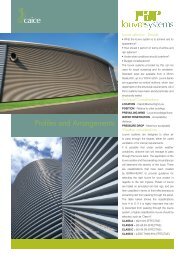CAICE Attenuator
CAICE Attenuator
CAICE Attenuator
Create successful ePaper yourself
Turn your PDF publications into a flip-book with our unique Google optimized e-Paper software.
We also test two random attenuators, shown in the table by the <br />
and compare the test data to the predicted data. Typical results<br />
are shown below that highlight the accuracy of this technique.<br />
Static Insertion Loss at 27.5%FA<br />
(dB) in each Octave Band centre frequency (Hz)<br />
63 125 250 500 1k 2k 4k 8k<br />
Predicted 6.4 9.4 17.1 34.7 49.2 38.2 23.9 18.8<br />
Measured 5.7 9.2 16.9 35.6 50.0 39.3 24.2 19.4<br />
Diff 0.7 0.2 0.2 -0.9 -0.8 -1.1 -0.3 -0.6<br />
Static Insertion Loss at 45.0%FA<br />
(dB) in each Octave Band centre frequency (Hz)<br />
63 125 250 500 1k 2k 4k 8k<br />
Predicted 4.5 5.7 11.7 25.9 32.6 19.1 12.4 9.3<br />
Measured 3.9 5.5 11.8 26.2 32.4 18.8 13.6 9.7<br />
Diff 0.6 0.2 -0.1 -0.3 0.2 0.3 -1.2 -0.4<br />
Performance Data you can Trust<br />
<strong>Attenuator</strong> performance is an immensely complex topic and<br />
<strong>CAICE</strong> are very much on the leading edge of development work<br />
in this field of acoustics.<br />
Our research work is ongoing as we constantly look to improve<br />
our methods and accuracy of performance data.<br />
We hope that this again underlines our position as the<br />
leading UK attenuator manufacturer and helps to provide<br />
our clients with performance data that you can trust.<br />
<strong>Attenuator</strong> Performance in the Real World<br />
<strong>Attenuator</strong> testing to ISO 7235 provides performance data that is<br />
achieved in ideal laboratory conditions.<br />
How is this performance data affected when attenuators are<br />
installed in non-ideal conditions<br />
Dynamic Insertion Loss is meant to account for the change in<br />
performance that occurs as the airflow increases through an<br />
attenuator.<br />
However ISO 7235 states that where the airway velocity falls<br />
short of 20m/s airflow will hardly have an effect on the insertion<br />
loss. Therefore up to this velocity the difference between Static<br />
Insertion Loss and Dynamic Insertion Loss is negligible, and this<br />
has been proven during our test programme.<br />
An airway velocity of 20m/s would correspond to an attenuator<br />
pressure loss of between 100 to 200Pa, depending on the free<br />
area of the attenuator.<br />
<strong>Attenuator</strong>s are generally selected to a maximum pressure loss<br />
of 50Pa, and therefore Dynamic Insertion Losses are of little use<br />
for day to day attenuator applications.<br />
<strong>CAICE</strong> have therefore adopted a policy to use Static Insertion<br />
Losses for selection of attenuators, although we can provide<br />
Dynamic Insertion Losses if required.<br />
Two other problems exist with Dynamic Insertion Losses:<br />
1. Dynamic Insertion Losses are determined in the laboratory<br />
under ideal airflow conditions. What happens when the<br />
attenuator is subjected to the sort of turbulent airflow<br />
conditions that often exist on site ISO 7235 points out that a<br />
design airway velocity of 10 to 15m/s may give you 20m/s on<br />
site due to non-uniform airflow distribution. It is impossible to<br />
predict how evenly the air will flow through the attenuator on<br />
site, which again makes Dynamic Insertion Losses<br />
questionable.<br />
2. Even if attenuator manufacturers can provide Dynamic<br />
Insertion Losses, how accurate are they <strong>CAICE</strong> are<br />
currently the only attenuator manufacturer in the UK that can<br />
provide both Static and Dynamic Insertion Losses in<br />
accordance with ISO 7235: 2009 and our latest very stringent<br />
test procedures provide good accuracy. We would seriously<br />
question data derived from other, older test standards, or<br />
where manufacturers have not ensured that the test<br />
attenuators are constructed to the highest standards.<br />
<strong>Attenuator</strong> pressure loss and flow generated noise can be<br />
adversely affected by poor airflow conditions on site. <strong>Attenuator</strong>s<br />
should therefore be installed as far away as possible from<br />
bends, change of sections, fan discharges, etc, to ensure that<br />
airflow is uniformly distributed across the attenuator.<br />
Where poor airflow conditions do exist across attenuators, the<br />
site pressure loss can be up to two or three times the expected<br />
laboratory pressure loss. Flow generated noise through the<br />
attenuator will also increase considerably.<br />
If In Doubt Test It<br />
We hope that this section of the brochure has provided a good<br />
overview of the complexities of <strong>Attenuator</strong> Performance.<br />
However if you have any doubts at all over attenuators that are<br />
required for a particular project then we would be pleased to<br />
provide further advice accordingly.<br />
The <strong>CAICE</strong> <strong>Attenuator</strong> Testing Laboratory is also available<br />
to our clients to substantiate performance data where<br />
required, and our advice would generally be that if you have<br />
any doubt at all then test it.<br />
www.caice.co.uk<br />
<strong>CAICE</strong> <strong>Attenuator</strong> Brochure<br />
39
















